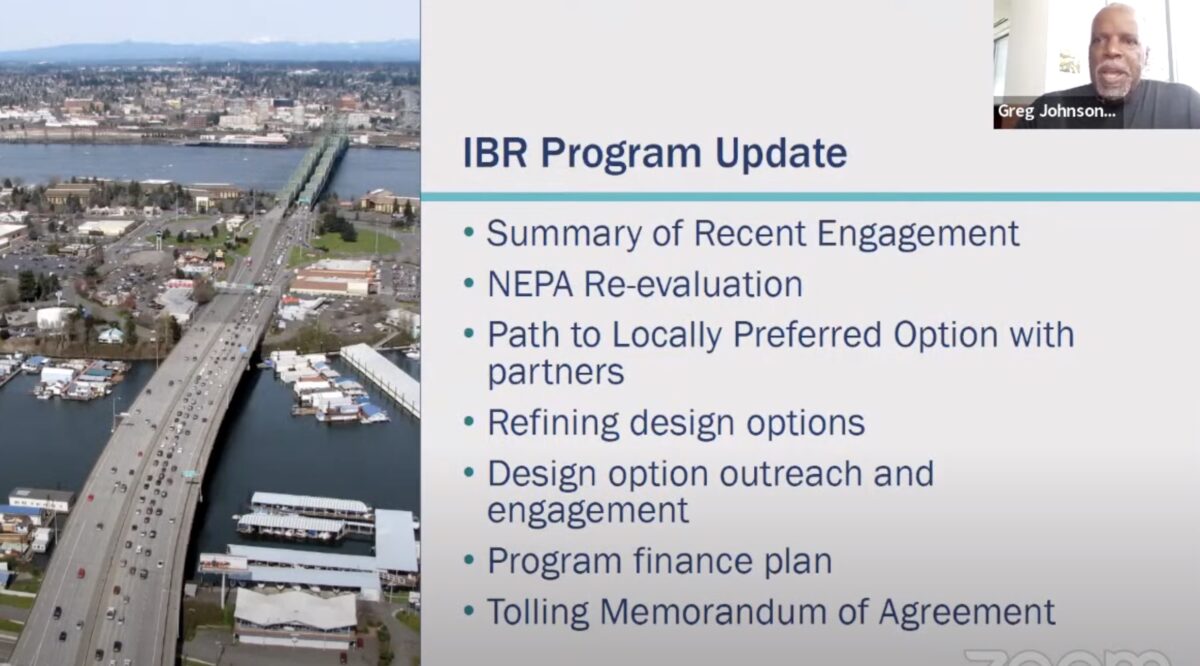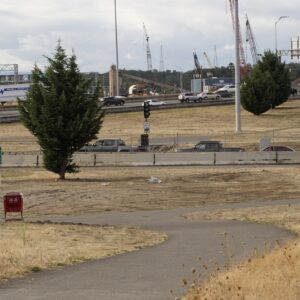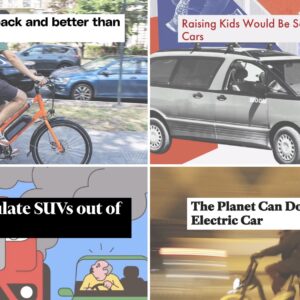
You might have heard that the Washington legislature has finally ponied up some cash — $1 billion to be exact — to help pay for a freeway expansion and bridge megaproject between Portland and Vancouver. This is great news for boosters of the project and elected officials, because it was that same legislative body that killed the project (formerly known as the Columbia River Crossing) in 2013 when they opted not to fund it out of fear that it would include light rail.
But while glasses are raised in celebration of a major funding milestone, the vibes on this project were anything but celebratory at the Oregon Transportation Commission meeting Thursday.
“Is the IBR and the Rose Quarter really where our state wants to spend the money?”
— Sharon Smith, OTC
“We don’t have the dollars to do this.”
— Julie Brown, OTC
At the meeting, Commissioners heard an update on the Interstate Bridge Replacement Program (IBR) from project administrator Greg Johnson (above). Johnson gave an update on the financing of the project and explained that the current cost estimate is $3.2 to $4.8 billion. He painted an optimistic picture of the commitment from Washington, saying that it’s a “very important step” and a “signal to federal partners that we are serious about getting this program done.”
But almost immediately, four of five OTC members expressed deeply skeptical views of the future funding prospects of not just the IBR, but other freeway expansion projects in the Portland region. It was a rare expression of doubt from a powerful body that sets ODOT policy and an illustration that cracks might be forming in Oregon’s plans to continue widening freeways despite crises around oil production, the price of gas, climate change, and growing public backlash.
Keep in mind that the $1 billion from Washington would just cover their local share. If the project ever gets built, that funding would need to be combined with Oregon’s share (which would also be $1 billion), a big grant from the federal government, and tolls. And those are just construction dollars. The old CRC spent around nearly $200 million on planning and the current IBR team of staff and consultants are burning through $80 million in administrative expenses.
Commissioner Julie Brown was first to throw cold water on Johnson’s presentation. She’s worried that ODOT is taking too long to begin tolling to pay for this and two other freeway expansions (the I-5 Rose Quarter and I-205 Abernethy Bridge project near Oregon City). IBR staff says they don’t expect to start tolling until late 2025 or early 2026. “The longer this project goes, the more it’s going to cost,” Commissioner Brown said. “You know, are we being realistic in waiting? If we’re going to do this, let’s just do it. I mean, what are we waiting for? It’s going to hurt [politically], but this is the reality. We don’t have the dollars to do this.”
“I’ll probably never be elected to any office because of my statements,” Brown continued. “But we have to pay for this. And so let’s be real about it.”
Why is Brown so eager to start tolling? Because none of the projects pencil out without toll revenue.
Advertisement
“I’ll just say it,” OTC Chair Bob Van Brocklin said in reply to Brown’s comment. “I don’t think this bridge gets built without being tolled.” Van Brocklin doesn’t think ODOT can build any of the freeway megaprojects they have on tap without a regional tolling system in place. He also pointed out that Oregon doesn’t even have a tolling office set up yet and it’s going to cost $400 to $500 million to create one. And this is to say nothing about the potential political blowback when the public realizes they’ll be charged for something they’ve always done for free.
A few minutes later Van Brocklin said,
“I think it comes down to this simple conclusion, which is, if we don’t have tolling, I don’t see an alternative funding mechanism to do any of these. I don’t think we don’t have the resources to build the Abernethy Bridge, the Rose Quarter project, or the Interstate Bridge without tolling… I just think that’s the reality of it.”
Another big dose of reality came when Commissioner Sharon Smith piped up with her concerns about funding these projects. Smith mentioned the ongoing conversation about how to spend $400 million coming to Oregon as part of the federal Infrastructure Investment and Jobs Act (IIJA) and how the OTC has heard loud and clear that the public wants those funds reserved for things like transit, bicycling, and other climate-resilient projects.
“It just makes me ask the question: Is the IBR and the Rose Quarter really where our state wants to spend the money?”
Johnson retorted quickly that some federal funds are earmarked for massive freeway projects and that if Oregon doesn’t get them, they’d be sent to another state.
Smith said, “I totally understand that. But we’ve still got to come up with a billion dollars at the state level.”
At that point, Chair Van Brocklin continued to share very candid comments about the corner the State of Oregon has painted itself into by pushing for so many expensive freeway projects:
“We’re’re not going to raise $3.5 billion, $4 billion, or a billion for the Rose Quarter or whatever the number is for the Abernethy. We have been directed to toll. It’s a statue statutory mandate. And we’ve been directed to build the I-205 and the Rose Quarter projects. So maybe all those get reviewed at the legislature.”
Advertisement
Is Van Brocklin suggesting that the legislature re-think it’s decisions to force ODOT’s hand on these projects? (Keep in that the legislature never detailed what type of project ODOT should build, they only directed them to solve congestion. ODOT chose wider freeways instead of other options.)
Sensing skepticism from fellow commissioners, Van Brocklin then questioned whether the IBR would ever even happen. “I find it hard to imagine that at some point, we’re not going to do something with the Interstate Bridge.” Then, after throwing major shade at the Washington legislature for the failure of the CRC in 2013 (“if [they had] shown leadership and approved it, it would be up, we’d be using it”), Van Brocklin turned to ODOT Director Kris Strickler and asked, “Don’t you think it’s inevitable? I mean, it’s so old!”
Strickler didn’t take the bait and replied that without broad partnerships and a funding package that pulls from many sources, “I don’t see big projects like this going forward.”
Asked for his comment on the situation, OTC member Alando Simpson lamented on the lack of unity in Oregon around support for the IBR and other freeway megaprojects. “Our problem is we have too many divorces going on around here… everybody’s on their own path right now and nobody’s working in unison towards the North Star. So that’s why we have the dysfunction that we have.”
Simpson warned that Oregon must work on being more unified or federal funding will pass us by.
This debate will heat up when the Oregon Legislature convenes again in 2023. ODOT Government Affairs Director Lindsay Baker shared at yesterday’s meeting that they plan to introduce a bill specifically to settle the debate on IBR project funding. Stay tuned.






Thanks for reading.
BikePortland has served this community with independent community journalism since 2005. We rely on subscriptions from readers like you to survive. Your financial support is vital in keeping this valuable resource alive and well.
Please subscribe today to strengthen and expand our work.
(Keep in that the legislature never detailed what type of project ODOT should build, they only directed them to solve congestion. ODOT chose wider freeways instead of other options.)
I think it was fairly clear at the time that the legislature was expecting ODOT to widen the freeway in combination with a new tolling system.
There’s “clear” then there is the letter of the law. The text never said widen a freeway.
And I realize this is a fringe point to make. Just bugs me when they say “The legislator is making us do this!” When the fact is the leg just told them to fix congestion.
In many states, highway projects won’t get funded unless they expand roadway capacity by adding more lanes or lane width. Even if Oregon doesn’t require the same, the engineers and planners it hires from other states have it “hardwired” in them to do so.
It was already beyond fixing congestion at the time HB2017 passed. I’m not able to find the original documents from 2017 but I believe it cited specific documents on file and an initial estimate as to what the cost would be.
The pressure really needs to be on the city of Portland and the local legislators. They need to say cancel this project and return the money to the state pool. The problem is they want the money and they want the side projects that will be completed as part of the freeway widening.
The original ODOT cost estimate was $450 million in 2017. That nearly doubled to $795 million in 2020. The latest estimate now says $1.25 billion to 1.45 billion. Virtually every ODOT project with an initial cost estimates of $100 million or more has had a 100% cost overrun. https://cityobservatory.org/rosequarter_cost_overrun/
The Legislature also directed them (and everyone else) to reduce greenhouse gases by 75 percent from 1990 levels by 2050, and they are utterly failing to do that–and don’t seem to care: https://cityobservatory.org/oregondotclimatefail/
Any money that Oregon leaves on the table, states like NC will grab and find match for our endless (and totally useless) freeway projects.
Thanks for this exciting news highlighting the cracks in the OTC! No we are not all “working in unison towards the North Star” of endless freeway expansion to reduce congestion. Some OTC Commissioners are thinking about huge and long delayed maintenance bills, others may have finally internalized the inevitable foolishness of induced demand, and still others may have opened their hearts to the Sunrise Youth v. ODOT kids and rethought the world they are leaving as their legacy.
Whatever, I’m glad it is happening. With billions on the ODOT table, I hope some staff proposals are risking something besides more car lanes to reduce congestion — bus lanes, rail, demand reduction, bike lanes, heck, even the frog ferry deserves some love. We just can’t keep building for cars, cars, and more cars. Car lane projects won’t reduce congestion in today’s world, and certainly won’t serve our needs in the future.
Why not toll now and then see if we still have congestion? My understanding of tolling is that if you play with the rates a little you can solve most any congestion problem, and never need to spend those other billions.
Come on folks!
But can we trust our politicians much less ODOT to do it right? I sure don’t.
They (mostly the constrution industry) wants those billions in their pockets. So whatever it takes (usually happens behind closed doors) they’ll do it to sabotage what might be the right way if it interferes with their profits.
There are no alternative routes though. How are tolls going to reduce throughput on the interstate?
Tolls reduce non-commute trips, and have the potential to shift demand to off hours if they are setup on a surge pricing system. Tolls reduce demand… adding freeway supply increases demand, start tolling now and we will see how much true demand there is.
I doubt there are enough non-commute trips happening to make an impact in congestion in Oregon.
It’ll be interesting to see what happens when demand/congestion doesn’t go down in any meaningful way and ODOT gets a brand new slush fund for highway expansions. Watching alternative transportation champions cheer this regressive tax on is bemusing.
Don’t count on that big grant from the federal government with republicans likely to take back Congress next year and the Presidency in ’24. Plus, by then, climate catastrophes, emerging pandemics, The Big One(?), and a catastrophic swing toward more support for Putin in his ongoing wars will take center stage.
Bottom Line: It will never be built.
The lack of interest in or discussion of this stark likelihood among “progressives” is reminiscent of their lack of interest in the impact that their hyper-consumption and animal-agricultural-centric lifestyles have on the rapidly worsening climate crisis.
The capacity of the global top 10% to continue to trash our shared ecology while espousing concern about “climate crisis” knows no end.
It’s really horrifying that hyper-nationalist authoritarians, like Trump, will likely decide who suffers and dies as the climate crisis becomes more dire.
Simpson continues to disappoint.
Would be shocked if they’re not rolled.
This is the pattern:
– Be connected to reality that we can’t afford huge polluting highway expansions
– Express that publicly
– Get lobbied like hell behind scenes
– Get sold that ODOT will make sure everything works out with a values document and a vastly under-projected project cost (like, more than 50% less than it will actually cost)
– Sign off on first steps
– Feel like “well, we’ve already spent some money so it’d be a waste not to throw billion$$ more into this money pit.”
It’s just SO predictable.
I wouldn’t cry at federal dollars earmarked for freeway expansions passing us by
There is a one very positive and shovel ready freeway project, and that is the I-205 Corridor Improvement project. It eliminates a major bottleneck that has created far too much congestion related carbon emissions and diverted traffic into the I-5 Corridor, where it creates even more congestion and carbon emissions. The I-5 Corridor is basically unable to provide what is needed for National Security and Interstate Commerce and Freight Movement. This I-205 project also makes the critically needed seismic retrofits to the I-205 Abernethy Bridge, to enable it to survive a major earthquake. The use of Tolling to fund out this project would create massive diversion on to secondary side street, arterials, highways, and bridges that do not have the capacity or safety considerations in their designs to handle the foreseen re-routing. This area is also in a transit wasteland where there are little or no multi-mode alternatives or options. Equally there are no parallel re-routing options and with Tolling, there will be 10 x greater negative impact on economic activity. With the plan to Toll the I-205 Abernethy Bridge in all direction and it eliminates the ability of choice to not pay a Toll as there are virtually no other option to get across the Willamette4 River for 50 miles. This proposed Tolling disproportionately harms this regional area of Clackamas County and its Cities and there are no effective ways to mitigate what would happen. Cities like Oregon City and Canby will be devastated with diverted traffic that would shut down Hwy 99E/McLoughlin Blvd, as traffic quadruples over the Historic, Arch Oregon City – West Linn Bridge.
The sky is falling!
You say “it will eliminate a bottleneck” – but all the available evidence is contrary to that. Making it easier to drive in an area will make more people drive more – increasing pollution. This is induced demand.
“Eliminating” one bottleneck creates another bottleneck elsewhere on the system, because more people are driving.
Read all about it.
The one thing that actually reduces driving (other than economic downturn or increased gas and parking prices) – tolling – is something you rail against.
I’m glad we’re not all pulling in the same direction if the direction is expanded freeways.
Shame that their plans on the WA side will still result in a divided Vancouver. If they have all this money to slush around at least make something better.
In Portland, the Rose Quarter project is veering this way, however, an I5 removal or burial (tunnel, not RIP boo..) would be worth nearly any cost.
This is a jobs project. We know from 75 years of experience that the wider freeway will generate more traffic, pollution, and sprawl.
For context:
How much money is $5 billion? A lot.
Let’s use $2 billion to fix/build a reasonable, safe bridge. To control auto-demand, and encourage efficient use of transit, let’s use the remaining $3 billion to pay 30,000 transit riders $5 per trip each way. With $3 billion and a bit of interest earnings that program could continue 5 days a week for 40 years. Toll revenue could extend the program.